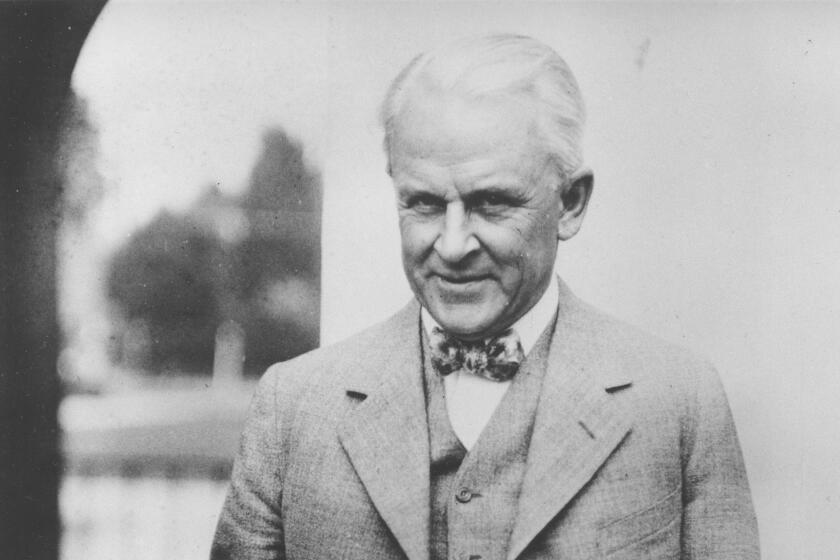Column: The roots of anti-Asian violence can be found in California history
- Share via
California takes justifiable pride in its exports to the rest of the United States, including world-changing technologies and society-changing political values.
Here’s an export that should prompt the state to hang its head in shame: The anti-Asian movement in America, which only now is receiving the attention it deserves, was born and bred in California.
Prejudice against Asian people, chiefly Chinese and Japanese residents, dates back more than 150 years in the Golden State. Over that time California labor unions and political leaders elevated what began as local conflicts into a national issue.
I’ve been delving into the history of Chinese and Japanese prejudice as part of the research for my next book, a history of California. What I’ve found is a dark undercurrent of racist sentiment that runs deeply within the California pageant.
California history bristles with violent attacks on Chinese individuals, including an outbreak of lynchings of Chinese residents in Los Angeles in 1871, and on Chinese neighborhoods in San Francisco and Los Angeles.
Eventually their pressure prompted President Chester A. Arthur to sign the notorious Chinese Exclusion Act of 1882. The act was consistently strengthened over the ensuing decades and not repealed until 1943 (and then only partially).
Get the latest from Michael Hiltzik
Commentary on economics and more from a Pulitzer Prize winner.
You may occasionally receive promotional content from the Los Angeles Times.
In the early 20th century, racial animosity turned to the Japanese. In 1907, San Francisco banned Japanese students from its public schools — even as the Japanese government contributed $246,000 to a relief fund for victims of the 1906 earthquake.
The incarceration of Japanese residents, including U.S. citizens, in camps during World War II is often treated as if it originated with the Roosevelt White House. In fact it was born in the fever dreams of California politicians, who inaugurated and promoted the cry to exclude Japanese residents from the West Coast.
Among them was Earl Warren, who as the nation’s chief justice became known as a beacon of progressive judicial action. As California attorney general in 1942, however, he advocated forcefully to relocate all those with Japanese ancestry, citizens and otherwise, away from the coast.
From Marin County to the Mexican border virtually every important strategic location and installation has one or more Japanese in its immediate vicinity.
— California Atty. Gen. Earl Warren in 1942, justifying the relocation of Japanese residents
Warren’s testimony to a 1942 congressional committee in favor of relocation undergirded a comment by the supervisor of the relocation and incarceration program, Gen. John L. DeWitt, that it had been “instigated ... by the best people of California.”
(“Internment,” the term commonly used to describe the program, was a euphemism used by the government to sugarcoat what was actually happening — the mass incarceration in concentration camps of American citizens and others who had committed no crime but were held merely because of their ancestry.)
California and other Western states had the highest concentrations of Asian residents through the 19th century and into the 20th. From here, Asian racial stereotypes spread to the rest of the country.
Robert Louis Stevenson, traveling west to California on the transcontinental railroad in 1879, reported that the one sentiment all his fellow white passengers seemed to share — which Stevenson judged “the most stupid and the worst” — was scorn for Chinese passengers, who were sequestered in their own car.
Chinese immigrants first came to California in significant numbers during the Gold Rush, with most employed in the mines or serving as merchants of clothing and equipment for miners.
After the mines were played out and gold fever ebbed, a new opportunity appeared — for laborers on the Central Pacific Railroad, which was making its way east from Sacramento toward its eventual meeting with the Union Pacific at Promontory Summit, Utah, on May 10, 1869, creating the first transcontinental railroad.
At first the Central Pacific shunned Chinese labor. “I will not boss Chinese,” declared its construction chief, James Strobridge. But on the day construction began, the railroad needed 5,000 workers and had only 600, all white, on hand.
Strobridge soon came to appreciate the Chinese workforce — but he didn’t pay them fairly. On June 24, 1867, the entire Chinese workforce stopped work, demanding pay parity with their white counterparts. (The strike lasted eight days, until the company quietly raised wages, though not to parity.) Eventually the railroad would employ some 12,000 Chinese workers.
After the railroad’s completion, many Chinese workers moved into San Francisco and other cities. There they began to compete in the labor force with white workers, coming to dominate certain industries such as cigar-making.
By the late 1860s what had started as resentment about Chinese laborers accepting lower wages and thus taking jobs from white workers had morphed into full-blown racist animosity.
In February 1867 a mob attacked groups of Chinese labors in San Francisco and set fire to their housing. In October 1871 occurred what became known as the “Chinese Massacre” in Los Angeles.
The riot began after a shootout between rival Chinese gangs resulted in the wounding of a white policeman and the death of a civilian police employee. A mob descended on the Chinese residential district and lynched at least 10 and possibly as many as 18 Chinese men. Ten rioters stood trial and eight were convicted of manslaughter, but the sentences were overturned and the cases never retried.

In that era, casual anti-Asian racism was an accepted part of public discourse in California. On Feb. 15, 1882, The Times published a one-sentence notice of the death of a Chinese professor at Harvard on its front page, under the headline, “A Good Chinaman.”
That same period saw the rise of the Workingman’s Party of California, led by a firebrand named Dennis Kearney whose watchword was “the Chinese must go.” Kearney wrote in his manifesto: “To an American, death is preferable to life on a par with the Chinaman.”
Chinese immigrants were accused of bringing infectious diseases into the country, of engaging in fraudulent business practices, and of threatening California’s white hegemony. In 1879, Kearneyism succeeded in winning voter approval for a new state constitutional convention.
Having traveled the difficult road of coming to terms with racism in its own past, Caltech on Friday said it would remove the names of Robert A. Millikan and five other important figures in its history from campus.
The result incorporated openly racist provisions. The new Constitution built on anti-Chinese statute that had been part of the California law books for decades, including a rule, upheld by the state Supreme Court in 1854, that no Chinese person could testify in a California court against a white defendant.
Among other features, the Constitution forbid California businesses to “employ, directly or indirectly, in any capacity, any Chinese or Mongolian,” who were also barred from public employment.
Municipalities were given power for “the removal of Chinese” to outside their borders, and authority was given the Legislature to enact laws barring the entry of Chinese immigrants into the state. (The anti-Chinese provisions were repealed in 1952.)
In the first decades of the 20th century, racist thought in California turned to the Japanese community, employing some similar stereotypes and some new ones.
The San Francisco school board’s exclusion of Japanese students was based on claims that the Japanese students were all males, their ethical standards were low, and almost all of them were actually adults, and allowing them to sit in classrooms alongside “twelve-year-old girls” posed a moral and physical threat.
California has the ability to fight its own coronavirus war, but there are limits to the state’s exceptionalism.
In fact, as the historian George Kennan determined, of nearly 29,000 pupils in San Francisco, only 93 were Japanese, 28 of them were girls, and of the 31 who were older than 15, only two were as old as 20. School teachers and administrators universally held that their Japanese students were among the best behaved and most industrious in their classrooms.
Nevertheless, anti-Japanese laws had the support of politicians across the partisan spectrum, including Gov. Hiram Johnson, a notable progressive. These included the Alien Land Law, which barred long-term leases to Japanese tenants and sales to Japanese nationals.
Anti-Japanese animosity in California prompted Theodore Roosevelt to reach in 1907 what became known as the Gentlemen’s Agreement, in which the Japanese government agreed not to issue new passports for laborers intending to travel to the U.S.
As it happened, the agreement led to an influx of Japanese women coming to the U.S. to join their husbands already in place, and having babies who were U.S. citizens. Anti-Japanese fervor intensified.
The coming of war brought it to a head. Pressure from California politicians to relocate Japanese residents away from the coast was unrelenting. As attorney general, Earl Warren commissioned a map of Japanese residential concentration.
In presenting the map to a congressional committee headed by Rep. John H. Tolan (D-Oakland) on Feb. 21, 1942, Warren declared that it “shows a disturbing situation.... From Marin County to the Mexican border virtually every important strategic location and installation has one or more Japanese in its immediate vicinity.”
This “appears to manifest something more than coincidence,” Warren said.
It was true that there had as yet been no cases of sabotage attributed to Japanese residents, Warren allowed. But that was just more reason for concern. “I believe that we are just being lulled into a false sense of security,” and that when the moment comes “it is going to mean disaster both to California and to our nation.... We are approaching an invisible deadline.”
The harvest, of course, was one of the darkest actions ever taken by the U.S. against its own citizens, the imprisonment of more than 110,000 people of Japanese ancestry, most of whom were U.S. citizens, from 1942 through 1945.
Warren resisted revisiting his role in this program almost to the end of his life. Finally, in his memoirs, he wrote that he “deeply regretted” the removal order and his testimony, and said the episode left him “conscience-stricken.” But as my former colleague Jim Newton observed in his magisterial 2006 biography of Warren, drafts of the memoirs suggest that his apology was “scaled up” after his death in 1974 and before the memoirs’ publication in 1977.
As this chronicle shows, eradicating racism in all its forms requires constant vigilance and counteraction. In California the battle has been nearly ceaseless since statehood in 1850, and it’s almost surely not over yet.
More to Read
Get the latest from Michael Hiltzik
Commentary on economics and more from a Pulitzer Prize winner.
You may occasionally receive promotional content from the Los Angeles Times.













